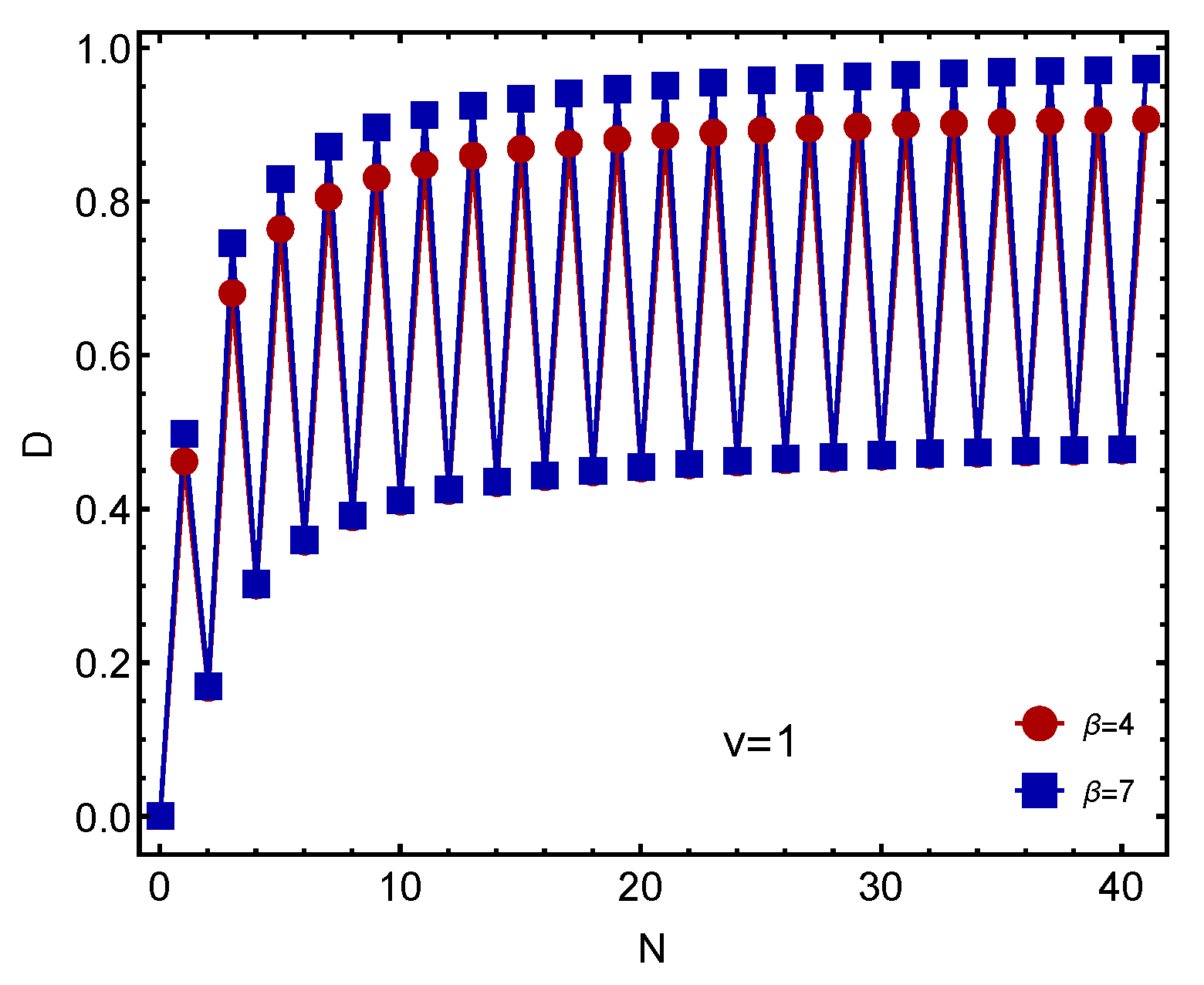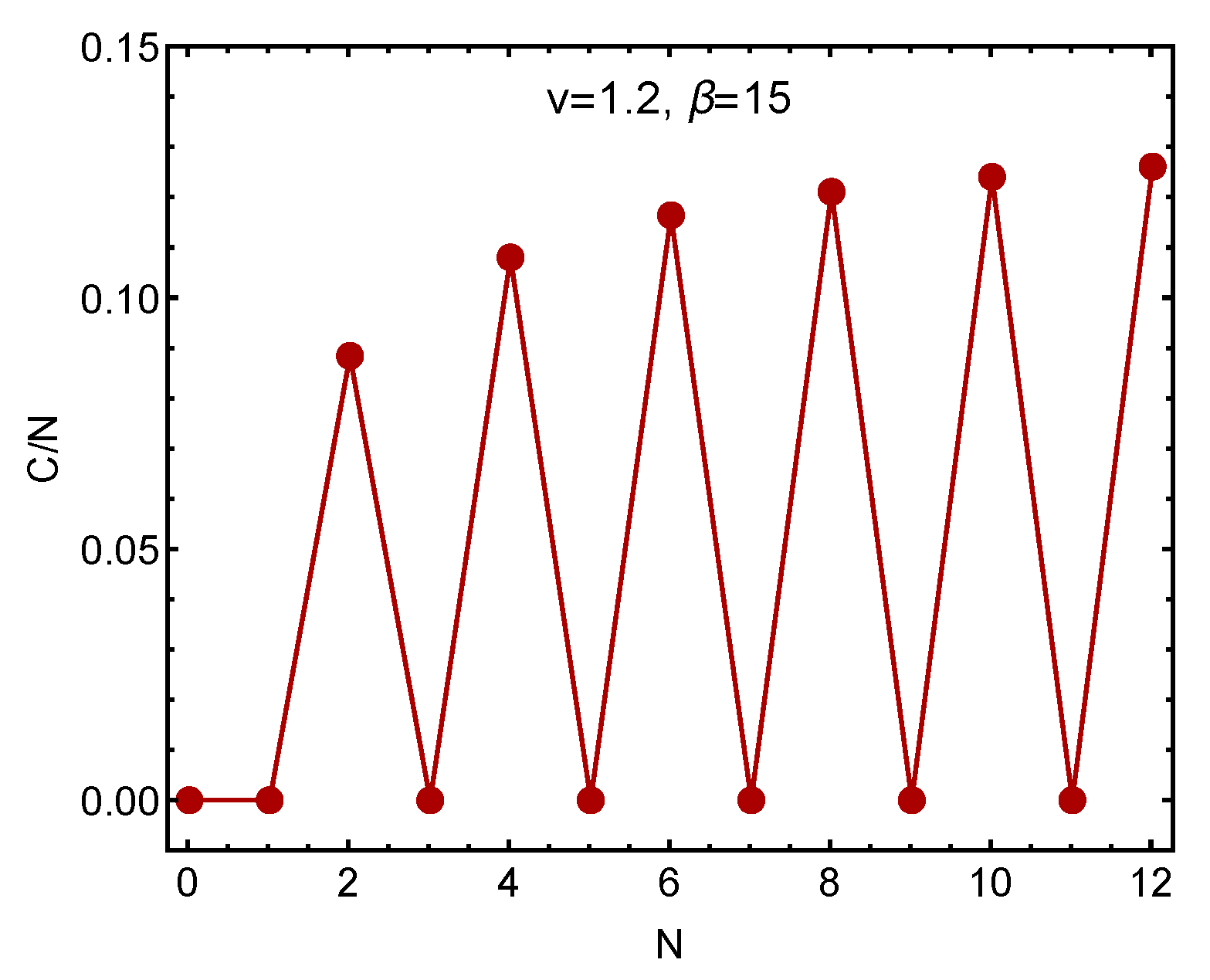Thermal–Statistical Odd–Even Fermions’ Staggering Effect and the Order–Disorder Disjunction
Abstract
:1. Introduction
Our Goal
2. The Model Discussed in This Review
2.1. Present Model
2.2. Model’s Details
2.3. Finite Temperatures
3. Statistical Complexity C and Thermal Efficiency
Thermal Efficiency
- (1)
- a negative -task is one of growing order,
- (2)
- a positive -task is one of growing disorder.
4. Depicting Staggering in Our Fermion-Model
5. Conclusions
- The thermal efficiency ,
- The disequilibrium.quantifier D, and
- The statistical complexity-quantifier C.
Author Contributions
Funding
Data Availability Statement
Conflicts of Interest
References
- Satula, W.; Dobaczewski, J.; Nazarewicz, W. odd–even Staggering of Nuclear Masses: Pairing or Shape Effect? Phys. Rev. Lett. 1998, 81, 3599–3602. [Google Scholar] [CrossRef] [Green Version]
- Sachdev, S. Quantum Phase Transitions, 2nd ed.; Cambridge University Press: Cambridge, UK, 2011. [Google Scholar]
- Rowe, D.J. Nuclear Collective Motion: Models and Theory; World Scientific: Singapore, 2010. [Google Scholar]
- Caurier, E.; Martínez-Pinedo, G.; Nowacki, F.; Poves, A.; Zuker, A.P. The Shell Model as Unified View of Nuclear Structure. Rev. Mod. Phys. 2005, 77, 427–486. [Google Scholar] [CrossRef] [Green Version]
- Dugett, T.; Bonche, P.; Heenen, P.H.; Meyer, J. Pairing correlations. II. Microscopic analysis of odd–even mass staggering in nuclei. Phys. Rev. C 2001, 65, 014311. [Google Scholar] [CrossRef] [Green Version]
- Ring, P.; Schuck, P. The Nuclear Many-Body Problem; Springer: Berlin/Heidelberg, Germany, 1980. [Google Scholar]
- Xu, F.R.; Wyss, R.; Walker, P.M. Mean-field and blocking effects on odd–even mass differences and rotational motion of nuclei. Phys. Rev. C. 1999, 60, 051301(R). [Google Scholar] [CrossRef] [Green Version]
- De Llano, M.; Tolmachev, V.V. Multiple phases in a new statistical boson-fermion model of superconductivity. Physica A 2003, 317, 546–564. [Google Scholar] [CrossRef]
- Uys, H.; Miller, H.G.; Khanna, F.C. Generalized statistics and high-Tc superconductivity. Phys. Lett. A 2001, 289, 264–272. [Google Scholar] [CrossRef] [Green Version]
- Kruse, M.K.G.; Miller, H.G.; Plastino, A.R.; Plastino, A.; Fujita, S. Landau-Ginzburg method applied to finite fermion systems: Pairing in nuclei. Eur. Phys. J. A-Hadron. Nucl. 2005, 25, 339–344. [Google Scholar] [CrossRef]
- Häkkinen, H.; Kolehmainen, J.; Koskinen, M.; Lipas, P.O.; Manninen, M. Universal Shapes of Small Fermion Clusters. Phys. Rev. Lett. 1997, 78, 1034–1037. [Google Scholar] [CrossRef] [Green Version]
- López-Ruiz, R.; Mancini, H.L.; Calbet, X. A statistical measure of complexity. Phys. Lett. A 1995, 209, 321–326. [Google Scholar] [CrossRef] [Green Version]
- Pennini, F.; PLastino, A. Statistical quantifiers for few-fermion’ systems. Physica A 2018, 491, 305–312. [Google Scholar] [CrossRef]
- Pennini, F.; Plastino, A.; Ferri, G.L.; Arizmendi, M. Statistical odd–even staggering in few fermions systems. Int. J. Mod. Phys. B 2021, 35, 2150092. [Google Scholar] [CrossRef]
- Plastino, A.; Ferri, G.L.; Plastino, A.R. Spectral explanation for statistical odd–even staggering in few fermions systems. Quantum Rep. 2021, 3, 166–172. [Google Scholar] [CrossRef]
- Lipkin, H.J.; Meshkov, N.; Glick, A.J. Validity of many-body approximation methods for a solvable model: (I). Exact solutions and perturbation theory. Nucl. Phys. 1965, 62, 188–198. [Google Scholar] [CrossRef]
- Plastino, A.; Moszkowski, S.M. Simplified model for illustrating Hartree-Fock in a Lipkin-model problem. Nuovo Cimento 1978, 47, 470–474. [Google Scholar] [CrossRef]
- Reif, F. Fundamentals of Statistical and Thermal Physics; McGraw-Hill: New York, NY, USA, 1965. [Google Scholar]
- Martin, M.T.; Plastino, A.; Rosso, O.A. Statistical complexity and disequilibrium. Phys. Lett. A 2003, 311, 126–132. [Google Scholar] [CrossRef]
- Rudnicki, L.; Toranzo, I.V.; Sánchez-Moreno, P.; Dehesa, J.S. Monotone measures of statistical complexity. Phys. Lett. A 2016, 380, 377–380. [Google Scholar] [CrossRef] [Green Version]
- López-Ruiz, R. A Statistical Measure of Complexity. In Concepts and Recent Advances in Generalized Information Measures and Statistics; Kowalski, A.M., Rossignoli, R.D., Curado, E.M., Eds.; Bentham Science Books: New York, NY, USA, 2013; pp. 147–168. [Google Scholar]
- Sen, K.D. (Ed.) Statistical Complexity, Applications in Electronic Structure; Springer: Berlin/Heidelberg, Germany, 2011. [Google Scholar]
- Mitchell, M. Complexity: A Guided Tour; Oxford University Press: Oxford, UK, 2009. [Google Scholar]
- Pennini, F.; Plastino, A. Disequilibrium, thermodynamic relations, and Rényi’s entropy. Phys. Lett. A 2017, 381, 212–215. [Google Scholar] [CrossRef]
- López-Ruiz, R. Complexity in some physical systems. Int. J. Bifurc. Chaos 2001, 11, 2669–2673. [Google Scholar] [CrossRef] [Green Version]
- Nigmatullin, R.; Prokopenko, M. Thermodynamic efficiency of interactions in self-organizing systems. Entropy 2021, 23, 757. [Google Scholar] [CrossRef] [PubMed]
- Plastino, A.; Arvieu, R.; Moszkowski, S.M. Surface Delta Interaction and Single Closed Shell Nuclei. Phys. Rev. 1966, 145, 837–851. [Google Scholar] [CrossRef]



Publisher’s Note: MDPI stays neutral with regard to jurisdictional claims in published maps and institutional affiliations. |
© 2021 by the authors. Licensee MDPI, Basel, Switzerland. This article is an open access article distributed under the terms and conditions of the Creative Commons Attribution (CC BY) license (https://creativecommons.org/licenses/by/4.0/).
Share and Cite
Pennini, F.; Plastino, A.; Plastino, A.R. Thermal–Statistical Odd–Even Fermions’ Staggering Effect and the Order–Disorder Disjunction. Entropy 2021, 23, 1428. https://doi.org/10.3390/e23111428
Pennini F, Plastino A, Plastino AR. Thermal–Statistical Odd–Even Fermions’ Staggering Effect and the Order–Disorder Disjunction. Entropy. 2021; 23(11):1428. https://doi.org/10.3390/e23111428
Chicago/Turabian StylePennini, Flavia, Angelo Plastino, and Angel Ricardo Plastino. 2021. "Thermal–Statistical Odd–Even Fermions’ Staggering Effect and the Order–Disorder Disjunction" Entropy 23, no. 11: 1428. https://doi.org/10.3390/e23111428
APA StylePennini, F., Plastino, A., & Plastino, A. R. (2021). Thermal–Statistical Odd–Even Fermions’ Staggering Effect and the Order–Disorder Disjunction. Entropy, 23(11), 1428. https://doi.org/10.3390/e23111428






